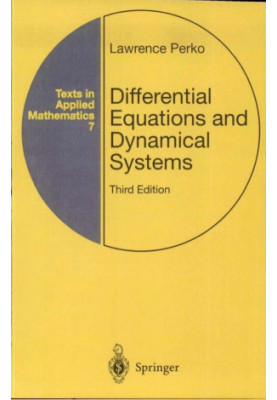Differential Equations and Dynamical Systems
 Instant download
Instant download
after payment (24/7)
 Wide range of formats
Wide range of formats
(for all gadgets)
 Full book
Full book
(including for Apple and Android)
This book covers those topics necessary for a clear understanding of thequalitative theory of ordinary differential equations and the concept ofa dynamical system. It is written for advanced undergraduates and forbeginning graduate students. It begins with a study of linear systems ofordinary differential equations, a topic already familiar to the student whohas completed a first course in differential equations. An efficient methodfor solving any linear system of ordinary differential equations is presentedin Chapter 1.The major part of this book is devoted to a study of nonlinear sys-tems of ordinary differential equations and dynamical systems. Since mostnonlinear differential equations cannot be solved, this book focuses on thequalitative or geometrical theory of nonlinear systems of differential equa-tions originated by Henri Poincarc in his work on differential equations atthe end of the nineteenth century as well as on the functional propertiesinherent in the solution set of a system of nonlinear differential equationsembodied in the more recent concept of a dynamical system. Our primarygoal is to describe the qualitative behavior of the solution set of a givensystem of differential equations including the invariant sets and limitingbehavior of the dynamical system or flow defined by the system of dif-ferential equations. In order to achieve this goal, it is first necessary todevelop the local theory for nonlinear systems. This is done in Chapter 2which includes the fundamental local existence-uniqueness theorem, theHartman-Grobman Theorem and the Stable Manifold Theorem. These lat-ter two theorems establish that the qualitative behavior of the solution setof a nonlinear system of ordinary differential equations near an equilibriumpoint is typically the same as the qualitative behavior of the solution setof the corresponding linearized system near the equilibrium point.After developing the local theory, we turn to the global theory in Chap-ter 3. This includes a study of limit sets of trajectories and the behavior oftrajectories at infinity. Some unresolved problems of current research inter-est are also presented in Chapter 3. For example, the Poincare-BendixsonTheorem, established in Chapter 3, describes the limit sets of trajectoriesof two-dimensional systems; however, the limit sets of trajectories of three-dimensional (and higher dimensional) systems can be much more compli-cated and establishing the nature of these limit sets is a topic of current
LF/520100/R
Data sheet
- Name of the Author
- Lawrence Perko
- Language
- English
- Series
- Texts in Applied Mathematics
- ISBN
- 9780387951164
- Release date
- 2001
- Volume
- 7













